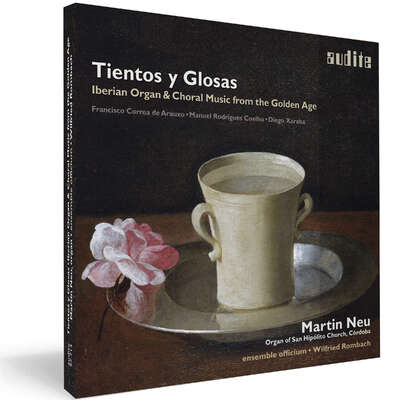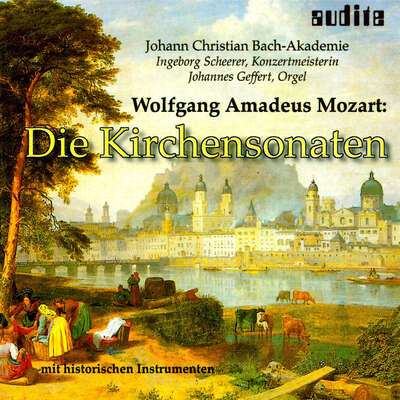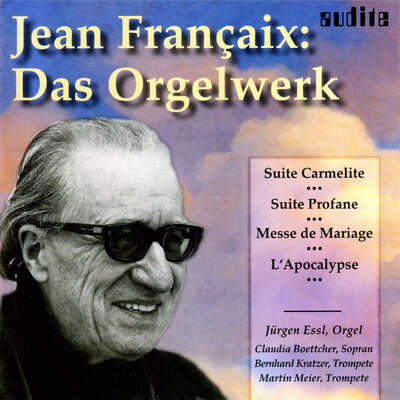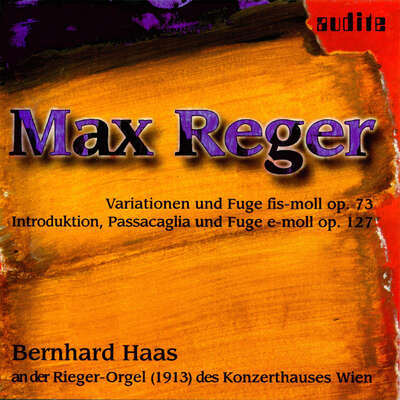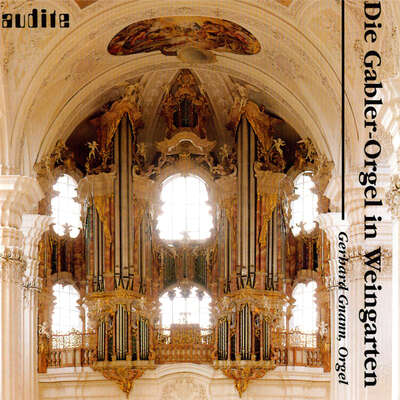
An der Orgel von San Hipólito in Cordoba erweckt Martin Neu Werke von Correa de Arauxo, Coelho und Xaraba in ihrem spanischen Ursprungsland zum Leben: Der Klang der Orgel entfaltet sich transparent im Kirchenraum, noble und warme Flautados und Flöten sowie eine Vielfalt charakteristischer Zungenregister verleihen dem Instrument klangliche Würde. Zusammen mit dem alternierenden Chorklang des ensemble officium zeigt diese Aufnahme facettenreich die Eleganz dieser Musikepoche.mehr
An der Orgel von San Hipólito in Cordoba erweckt Martin Neu Werke von Correa de Arauxo, Coelho und Xaraba in ihrem spanischen Ursprungsland zum Leben: Der Klang der Orgel entfaltet sich transparent im Kirchenraum, noble und warme Flautados und Flöten sowie eine Vielfalt charakteristischer Zungenregister verleihen dem Instrument klangliche Würde. Zusammen mit dem alternierenden Chorklang des ensemble officium zeigt diese Aufnahme facettenreich die Eleganz dieser Musikepoche.
Details
| Tientos y Glosas - Iberian Organ & Choral Music from the Golden Age | |
| Artikelnummer: | 97.713 |
|---|---|
| EAN-Code: | 4022143977137 |
| Preisgruppe: | BCA |
| Veröffentlichungsdatum: | 3. Juli 2015 |
| Spielzeit: | 54 min. |
Zusatzmaterial
Informationen
Das goldene Zeitalter (Siglo de oro) Spaniens begann während der Regentschaft Kaiser Karls V. (1516-1556). Die politische und wirtschaftliche Macht Spaniens führte auch zu einer Hochblüte von Kunst und Kultur. Zu den bedeutendsten Musikern dieser Zeit gehörten Francisco Correa de Arauxo und Manuel Rodrigues Coelho. Die wichtigste Gattung in der Tastenmusik war in dieser Zeit das Tiento. Ursprünglich eine imitierende Form, wird sie bei Correa de Arauxo durch seine Kreativität im Gebrauch der Harmonie, des Rhythmus und der Verzierungskunst zu einem Sinnbild barocker Freiheit. Aber auch die Kunst der Diminution eines Werks (Glosas) - die Auflösung des Tonsatzes in kleinere Notenwerte - führt Correa eindrucksvoll vor.
Die Orgel der San-Hipólito-Kirche in Córdoba wurde 1735 von Joseph Corchado gebaut. Im Lauf der Jahrhunderte wurde die Orgel verschiedenen Veränderungen unterzogen, jedoch waren es keine tiefgreifenden Eingriffe in ihren Aufbau und in ihre Disposition. Im Jahr 2006 wurde das ganze Instrument vollständig restauriert. Das Hauptanliegen dieser sorgfältigen Restaurierung war, den Charakter und die Ästhetik dieses einzigartigen Instrumentes zu bewahren und seine ursprüngliche Stimmung und Temperierung wiederherzustellen. Die eingespielten Werke erklingen so an einer Orgel, die der Klangästhetik ihrer Entstehungszeit so nah wie möglich kommt. Der alternierende Chorgesang ist mit dem Orgelklang verwoben und zeigt stilsicher Vokalaspekte der Epoche auf.
Besprechungen
Ars Organi | Jg. 67, H.3 (September 2019) | Martin Köhl | 1. September 2019
Die stilistisch mustergültige Interpretation und eine recht direkte, aber die Raumwirkung nicht verleugnende Aufnahmesituation rücken diese famose Orgel ins beste Licht.Mehr lesen
www.amazon.de | 18. November 2016 | Stephen Midgley | 18. November 2016 | Quelle: https://www.amaz... Customer Review: Fabulous organ music from Spain and Portugal's golden age
'Tientos y Glosas – Iberian Organ and Choral Music from the Golden Age' is the full title of this programme, played on the beautiful and colourfulMehr lesen
That's the factual bit over and so, to get to the point, the results are fabulous. The beautifully vivid Cordoba instrument is ideally suited to these dashing examples of Iberian baroque organ music, and Martin Neu's playing is superb – stylish, full of panache and imagination. Of the eight works on the disc, several of them ambitious and extended pieces, my own favourites are: Correa de Arauxo's Tiento y Discurso de medio registro de dos Baxones de Octavo Tono' (better get used to some long titles), a dramatic and colourful work with an almost Bachian opening but developed with increasingly extravagant ornamentation (track 3). Then comes Coelho's 'Ave Maris Stella' (track 4) consisting of imaginative variations on the hymn tune, alternating with sung verses as mentioned above; it sounds for all the world as if inspired by Monteverdi's movement of that title in the Vespers of 1610. Again, the result is splendid.
My last favourite is the final work, Correa de Arauxo's 'Tiento Tercera de Sexto tono sobre la primera parte de la Batalla de Morales', a piece of stunning brilliance, variety and drama. According to its title and the booklet notes, it's based on a lost work by Morales, but that's really a bit of a cheek because, like nearly all the 'battle' pieces of the renaissance and baroque, it owes just about everything to Janequin's wonderful chanson 'La Guerre'. But Correa's development of the work for organ is still a knockout, especially when played like this and on an instrument that couldn't be better suited to the task.
In addition to the three pieces described, the rest of the programme is a well-judged selection varying between excitement and meditation. The Ensemble Officium vocal group, directed by William Rombach, do their job very well, booklet notes are excellent, texts and translations are supplied for the few choral sections, and recorded sound is outstanding. This recording makes such an impact, and the organist's performance is so distinguished, that it had me searching to see what else Martin Neu has recorded. The answer, at the time of writing, is: very little so far. I hope that he and his recording company will be rectifying this in the near future. In the meantime, this is a brilliant and inspiring contribution to the catalogues.
Early Music Review | April 2016 | Alastair Harper | 1. April 2016
The real star of this fine recording is the magnificent 18c organ of the church of San Hipólito, Córdoba, dating originally from 1735 and superblyMehr lesen
SRF2 Kultur | Montag, 21. März 2016, 22.00 - 24.00 Uhr | Norbert Graf | 21. März 2016 BROADCAST Fiori musicali: Neue CDs mit Musik für Tasteninstrumente
Das Repertoire für Tasteninstrumente ist besonders umfangreich. Ob für Cembalo, Orgel oder Hammerflügel: Bekannte wie auch weniger bekannteMehr lesen
Zu hören sind Ausschnitte aus folgenden CD-Produktionen:
Cembalist Diego Ares spielt Antonio Soler
Organist Martin Neu spielt Werke aus dem «Goldenen Zeitaltler» Spaniens
Cembalistin Sonja Kemnitzer spielt Johann Adam Reincken
Organist Masaaki Suzuki spielt Johann Sebastian Bach
Organist Ingo Duwensee spielt Nicolaus Bruhns
Pianist Kristian Bezuidenhout spielt Wolfgang Amadeus Mozart
www.orgelnieuws.nl | 21/01/2016 | Theo Visser | 21. Januar 2016
niederländische Rezension siehe PDF!Mehr lesen
American Record Guide | January / February 2016 | Hamilton | 1. Januar 2016
Well here’s an organ that will knock your socks off—just wait till 3:30 on the first track (Diego in the alternatum tradition—that is where theMehr lesen
Also notable is the Coehelo ‘AveMaria Stella’. Mr Neu is at home with this music, expressing it naturally and fluently, with an expression that comes from the music. I recommend this especially to people who want to hear what an authentic 18th Century Spanish organ sounds like, and what the fuss was all about. Much of this music is not well known, or has not been recorded before. It is good to hear four selections by Francesco Correa de Arauxo played on this lovely organ.
Südwest Presse | 11.12.2015 | Paul Burkhardt | 11. Dezember 2015 Wenn das Licht am Himmel tanzt
Martin Neu entfaltet den ganzen Reichtum dieser Orgelmusik, lässt die improvisatorischen Freiheiten, die barocken Stilmerkmale und gelegentlich sogar Rhythmen der iberischen Folklore richtig aufblühen - warme Flöten- und markante Zungenregister. Die waagerecht in den Raum ragenden Trompeten zählen zu den bekannten Merkmalen des iberischen Orgelbaus. Martin Neus Album ist eine beeindruckende Zeitreise zurück in die Barockära und eine faszinierende Klangreise in den Süden, nach Andalusien.Mehr lesen
Reutlinger Generalanzeiger | Mittwoch, 9. Dezember 2015 | Armin Knauer | 9. Dezember 2015
Iberische Orgelmusik
Farbenpracht und zarte Andacht
Martin Neu gibt den zupackenden Stücken viel Schwung und bringt ihre synkopischen Rhythmen prächtig zum Tanzen. In den andächtigen Stücken beweist er großes Feingefühl. Die Sänger setzen mit ihren gregorianischen Melodien bewegende Ruhepunkte. Und die historische Orgel selbst entwickelt ein beeindruckendes Flair.Mehr lesen
La Tribune de l'Orgue | 67/4 2015 | gb | 1. Dezember 2015
Un très bon disque de musique ibérique, enregistré sur l'orgue (ancien, restauré) de San Hipólito de Córdoba. Très beaux timbres, registrations imaginatives et, entre autres, une pièce sensationnelle de Diego Xaraba (1652-1715). Une chorale excellente prête son concours.Mehr lesen
Fono Forum | November 2015 | Friedrich Sprondel | 1. November 2015 Quer durch den historischen Garten
Ein Charakteristikum der Orgelmusik ist die historische Breite des Repertoires, von der Notre-Dame-Epoche bis in die jüngste Gegenwart. Und aktuelleMehr lesen
[…] Martin Neu stellt auf der CD "Tientos y Glosas" Orgelmusik des spanischen "Goldenen Zeitalters" vor. Im Mittelpunkt steht Francisco Correa de Arauxo (1584-1654), der seine ingeniös vielfältige Orgelkunst in einem Lehrwerk niederlegte – was daran erinnert, dass Orgelmusik damals fast ausschließlich improvisiert wurde. Arauxos Lehrbeispiele sind gleichwohl Gipfelwerke, und die Stücke seiner Zeitgenossen Manuel Rodrigues Coelho und Diego Xaraba, mit denen Neu das Programm ergänzt, erreichen nicht ihre Originalität. In lebendig-rhetorischer Spielweise musiziert Neu an der Orgel von San Hipolito in Cordoba, einem charakterstarken Instrument von 1735, dessen Leuchtkraft von einer klar und weiträumig eingefangenen Akustik geadelt wird. Die vokalen Beiträge des Ensembles Officium überzeugen durch warmen Sound; doch nicht immer halten die Sänger die Tonhöhe, was beim Alternatim-Musizieren nicht verborgen bleibt.
www.musicweb-international.com | October 2015 | Johan van Veen | 1. Oktober 2015
Organ music by composers from the Iberian peninsula has a special place in the repertoire. Its peculiar style and the specific timbre of the organsMehr lesen
The music included on this disc is presented as being written during the Golden Age. However, the largest part of the repertoire played here was written when that era - roughly speaking from 1520 to 1620 - had come to an end. Moreover, one of the composers, Manuel Rodrigues Coelho, was Portuguese; in 1580 his country had lost its independence which was only restored in 1640. Coelho published his Flores de musica from which the pieces on this disc are taken in 1620. At that time the country was not in very good shape; it certainly was not enjoying a golden age. Coelho also did not dedicate his collection to Philip II, as Martin Neu writes, but to Philip III; his father had died in 1598. The information in the booklet in regard to the historical context is not very accurate.
Fortunately the information about the music is more reliable. The main genre in Iberian keyboard music is that of the tiento. This is what would be called a ricercar or fantasia outside Spain, and is characterised by counterpoint and imitation. Many tientos employ the medio registro, the 'broken keyboard'. In many organs the keyboard was divided into two halves with different dispositions. This allowed the composer to write a solo part for one hand, often including virtuosic figurations, and a polyphonic accompaniment for the other hand. A good example is the Tiento de medio registro de tiple de octavo tono by Francisco Correa de Arauxo. He seems to have been more or less self-educated and acquired his skills by studying the works of others. He was ordained a priest and worked for many years as an organist at the collegiate church of S Salvador in Seville. From 1636 to 1640 he held the same position in Jaén Cathedral. In 1640 he was elected a prebendary of Segovia Cathedral. Here he also died in poverty. His organ works are collected in one book which was printed in 1626 and has a clear didactic purpose as the title indicates. This explains why the pieces are arranged in various stages in order of difficulty.
The Tiento tercero de sexto tono sobre la primera parte de la Batalla de Morales refers to another popular genre in Spain: the battaglia. It is an arrangement of a batalla by Morales, the most famous Spanish composer from the first half of the 16th century. His batalla is lost and therefore this tiento by Arauxo is the only way to get some impression of what that piece may have sounded like. The closing episode includes some typical features of batallas: repeated fanfare motifs and echo effects. The Tiento de dos baxones de octavo tono is another brilliant piece with two independent bass parts. As Spanish organs usually didn't have a pedalboard these parts are played on the manuals. The Tiento lleno segundo tono is a late specimen of the genre of the tiento. It has come down to us anonymously but is attributed to Diego Xaraba for stylistic reasons. He was organist at the Royal Chapel in Madrid.
Another important genre is that of the glosas. These are not fundamentally different from diferencias, or - in other languages - divisions, diminutions or passaggi which were frequently written in England and Italy during the late 16th and early 17th centuries. The Tres Glosas sobre el Canto llano de la Immaculada Concepción is one of the best-known compositions by Arauxo and appears in many recordings of Iberian organ music. However, the Hymn to the Virgin Mary which is the subject of these variations is hardly ever sung. It is very nice that here the variations are embraced by a vocal performance of this hymn.
The third genre represented here is liturgical music. In the Catholic liturgy the organ played an important role in alternatim compositions: the verses of the mass or another liturgical chant were performed alternately by the choir and the organ. Here we hear two examples from the only published collection of keyboard music by Coelho, Flores de musica. It is the earliest surviving keyboard music printed in Portugal. According to the title the music is conceived for a keyboard instrument or the harp. It contains 24 tentos (Portuguese for tientos), three for every tone, and also over a hundred verses on various hymns and Kyrie settings. A specimen of the latter are the 5 Versos de Kyrie do 1. tom. The hymn Ave maris stella is also performed alternatim: the organ plays four verses with the cantus firmus moving from soprano to bass.
This disc offers a good survey of the keyboard music written on the Iberian peninsula during the 17th century. The value of this disc is enhanced by the fact that Martin Neu in his choice of repertoire has largely avoided the most obvious. Although Arauxo's music is often played, the pieces recorded here are not among the most frequently recorded, except the Glosas. Coelho's oeuvre is far less known. The collaboration with the ensemble officium in the liturgical pieces is another real bonus. On top of that Neu plays a magnificent organ, one of Spain's larger instruments with two manuals and 35 stops. The tuning is 1/5 comma meantone, the pitch is a=430 Hz. It dates from 1735 and was restored and partly reconstructed in 2006/2007. It proves itself the ideal medium for the music played here.
Footnote
Martin Neu has commented on a couple of points made in the review:
1) King Philip III of Spain was simultaneously King Philip II of Portugal (and of Sicily and Naples, and of Sardinia). As Coelho was Portuguese he dedicated his collection of keyboard works to 'his' King, which explains the reference to Philip II in the liner-notes
2) The 'golden age' (siglo de oro) is a fixed term for a period on the Iberian peninsula. That doesn't imply that it was a time of happiness and prosperity for the people. That is also not suggested in the liner-notes.
Musica | N° 269 Settembre 2015 | 1. September 2015
Martin Neu ha raccolto, nel CD AUDITE, opere di Arauxo, Coelho e Xaraba per eseguirle nella loro patria all’organo della Chiesa di San Hipòlito di Còrdoba. In abbinamento con l’Ensemble Officium, la registrazione rivela tutta l’eleganza del repertorio dell’epoca.Mehr lesen
http://theclassicalreviewer.blogspot.de | Saturday, 22 August 2015 | Bruce Reader | 22. August 2015 Audite’s new release Tientos y Glosas – Iberian Organ and Choral Music from the Golden Age featuring organist Martin Neu and Ensemble Officium directed by Wilfried Rombach is something of a winner for all lovers of early Iberian music
This is something of a winner for all lovers of early Iberian music. The recording captures this fine organ in its lovely acoustic superbly. There are excellent notes from Martin Neu as well as a full organ specification and details of tuning and temperament.Mehr lesen
RBB Kulturradio | Fr 14.08.2015 | Peter Uehling | 14. August 2015
Tientos y glosas
Spanische Orgel- und Chormusik des Goldenen Zeitalters – kundig eingespielt. Bisweilen mit fehlendem Glanz
In der späten Renaissance- und frühen Barock-Zeit stand Spanien auf dem Höhepunkt seiner Macht. In dem reichen Land blühten auch die Künste, dieMehr lesen
Großer Reichtum, kleiner Mangel
Die Grundformen der spanischen Orgelmusik sind Tiento und Glosa – dabei ist das Tiento eine freie Form, während die Glosa gregorianische Choräle oder Hymnen instrumental bearbeitet. Insofern gibt es in Spanien die gleiche Aufteilung wie in Deutschland zwischen Präludien, Toccaten und Fantasien einerseits und Choralbearbeitungen andererseits. In Spanien nimmt die Musik bauartbedingt zuweilen eine spezifische Form an: das Tiento de medio registro, in dem auf einem Manual durch Teilung der Lade zwei verschiedene Registrierungen möglich sind – natürlich auch auf dem 1735 gebauten Instrument von San Hipólito in Cordoba, das Martin Neu auf dieser Aufnahme spielt. Mystisches, Spielfreudiges, Strenges, aber auch Zupackendes findet sich auf dieser CD, ein großer Reichtum an Formen und Klängen, von Martin Neu stilistisch kundig eingespielt. Zu bemängeln wäre nur, dass sich die Auswahl auf drei Komponisten beschränkt und das ensemble officium, das zu den choralgebundenen Glosas die Hymnen singt, intonatorisch matt auftritt und einen anderen Stimmton wählt als die Orgel, was zuweilen irritiert.
Early Music Review | August 1, 2015 | D. James Ross | 1. August 2015
This CD of freely composed works and diminutions of originals is performed by Martin Neu on the 1735 Corchado organ of the San Hipólito Church inMehr lesen
Neuigkeiten
Customer Review: Fabulous organ music from Spain and Portugal's golden age
Als Martin Neu auf der Suche nach der idealen Orgel für die Einspielung...
Well here’s an organ that will knock your socks off—just wait till 3:30 on...
The real star of this fine recording is the magnificent 18c organ of the church...
BROADCAST Fiori musicali: Neue CDs mit Musik für Tasteninstrumente
Un très bon disque de musique ibérique, enregistré sur l'orgue (ancien,...
Martin Neu ha raccolto, nel CD AUDITE, opere di Arauxo, Coelho e Xaraba per...
Organ music by composers from the Iberian peninsula has a special place in the...
Audite’s new release Tientos y Glosas – Iberian Organ and Choral Music from the Golden Age featuring organist Martin Neu and Ensemble Officium directed by Wilfried Rombach is something of a winner for all lovers of early Iberian music
This CD of freely composed works and diminutions of originals is performed by...

